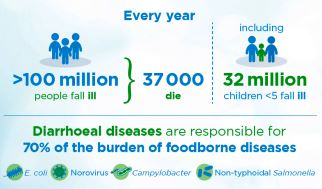 3 December 2015 – The findings World Health Organization’s (WHO) estimates of the global burden of foodborne diseases — the most comprehensive report to date on the impact of contaminated food on health and well-being are announced today in Geneva.
3 December 2015 – The findings World Health Organization’s (WHO) estimates of the global burden of foodborne diseases — the most comprehensive report to date on the impact of contaminated food on health and well-being are announced today in Geneva.
The report, which estimates the burden of foodborne diseases caused by 31 agents — bacteria, viruses, parasites, toxins and chemicals — states that each year as many as 600 million, or almost 1 in 10 people in the world, fall ill after consuming contaminated food. Of these, 420 000 people die, including 125 000 children under the age of 5 years.
The Eastern Mediterranean Region has the third highest estimated burden of foodborne diseases per population, after the African and South-East Asia Regions. More than 100 million people living in the Region are estimated to become ill with a foodborne disease every year and 32 million of those affected are children under 5 years.
Diarrhoeal diseases (caused by E. coli, norovirus, Campylobacter and non-typhoidal Salmonella) account for 70% of the burden of foodborne disease.
An estimated 37 000 people in the Region die each year from unsafe food, caused primarily by diarrhoeal diseases, typohoid fever, hepatitis A, and brucellosis. Both typhoid fever and hepatitis A are contracted from food contaminated by the faeces of an infected person and brucellosis is commonly caused by unpasteurized milk or cheese of infected goats or sheep. Half of the global cases of brucellosis are in people living in this Region, with more than 195 000 people infected every year, causing fever, muscle pain or more severe arthritis, chronic fatigue, neurologic symptoms and depression.








